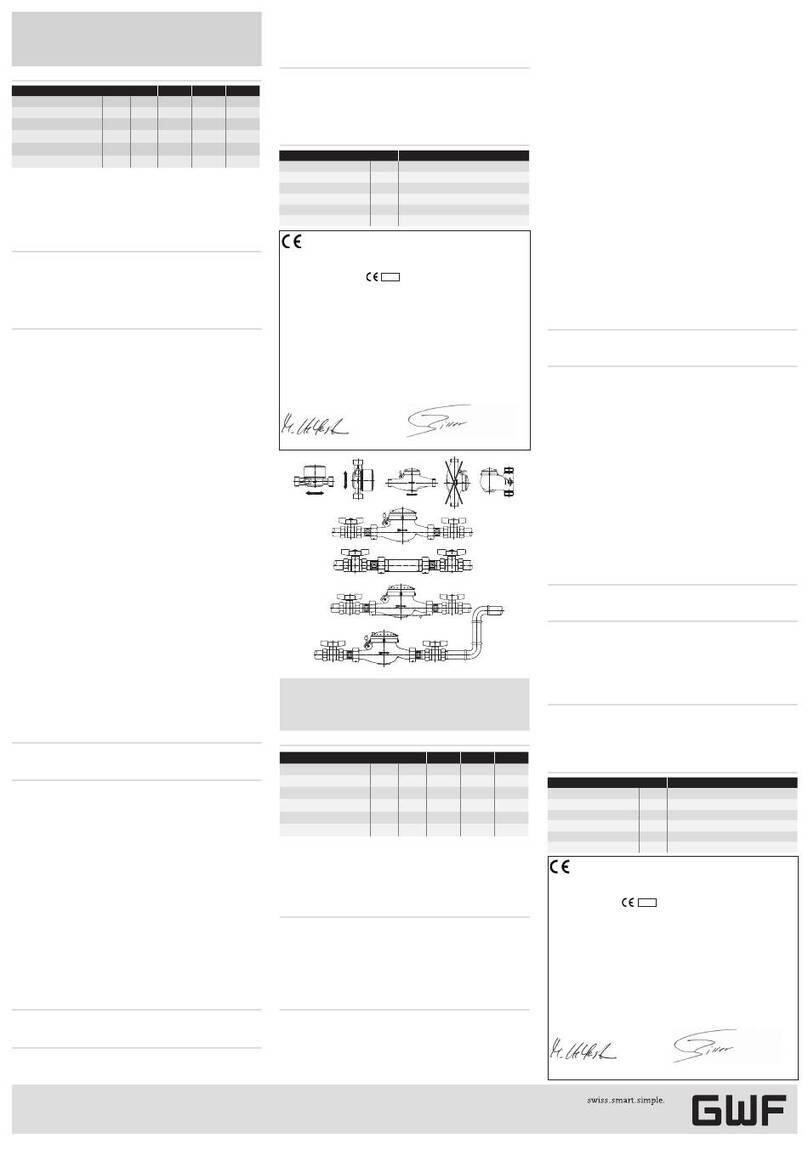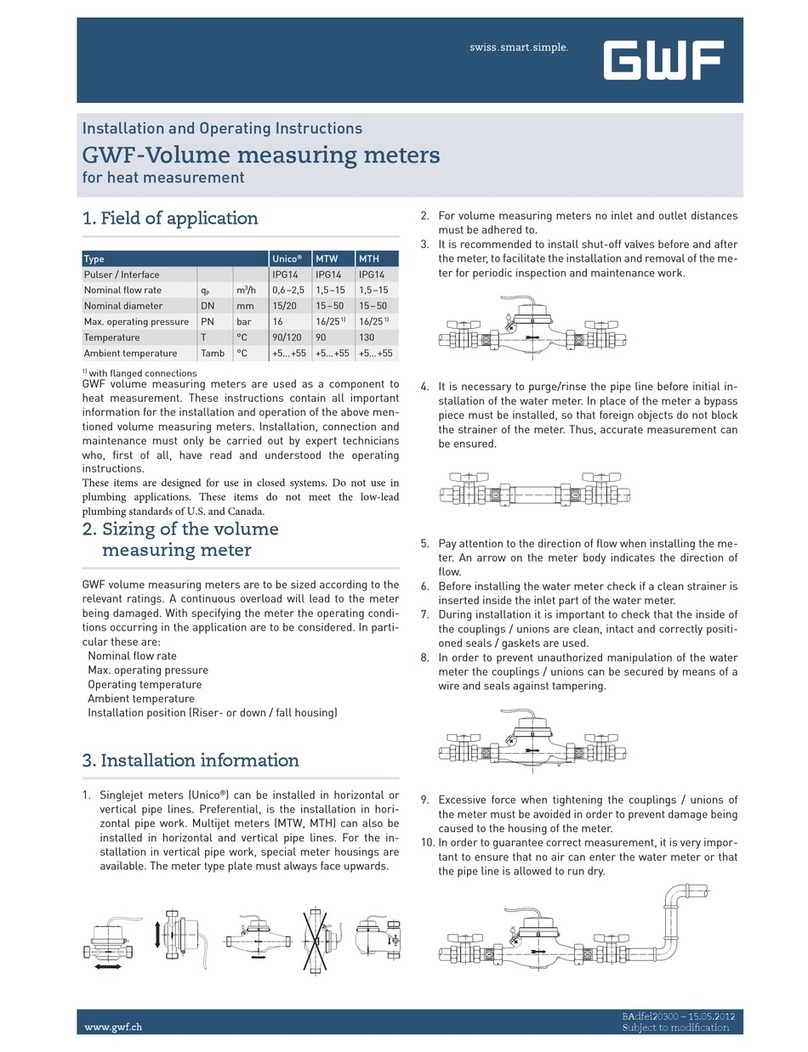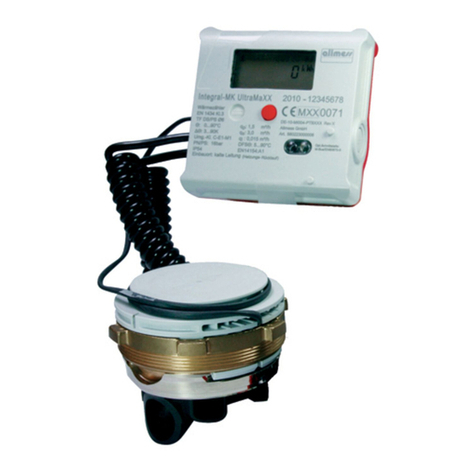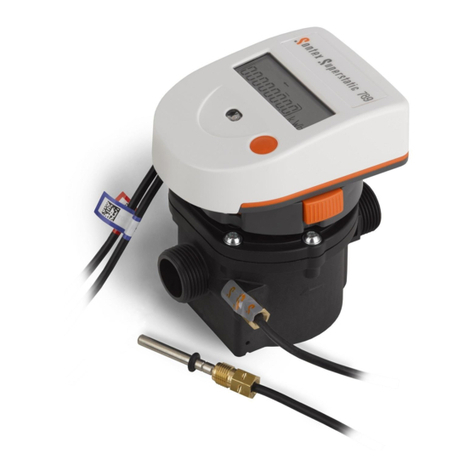
12. Il contatore d’acqua deve essere protetto dai danni dovuti
a urti o vibrazioni che possono essere causati nel sito di
montaggio.
13. Le tubazioni devono essere ancorate in modo sufficiente
prima e dopo il contatore d’acqua.
14. Occorre prendere precauzioni per evitare che il contatore
d’acqua venga danneggiato da effetti idraulici quali cavi-
tazione, contraccolpi (colpo d’ariete) o sbalzi di pressione.
Inoltre assicurarsi che il contatore d’acqua non venga dan-
neggiato da eventuale congelamento dell’acqua.
15. I cavi per la trasmissione degli impulsi non devono assolu-
tamente essere posati accanto alle linee di alimentazione
di rete e devono sempre essere protette. La distanza fra le
linee di trasmissione d’impulsi e quelle di alimentazione
deve essere di almeno 50mm.
4. Messa in servizio
Alla messa in servizio e dopo ogni svuotamento, aprire lenta-
mente i dispositivi di chiusura per evitare forti sbalzi di pressi-
one sul contatore d’acqua (colpo d’ariete).
5. Monitoraggio e manutenzione
Di norma i contatori d’acqua GWF non richiedono manutenzio-
ne. Si distinguono per una lunga durata d’impiego. Tale durata
dipende principalmente dalla qualità dell’acqua e dall’intensità
del flusso. Consigliamo in ogni caso di verificare periodica-
mente quanto segue:
1. Prima di intervenire sull’impianto, verificare che la tubazi-
one non sia in pressione.
2. Verificare che quando la condotta di alimentazione è chi-
usa tutti gli indicatori del contatore restino immobili e che
aprendo lentamente la condotta di alimentazione anche gli
indicatori si muovano lentamente e in modo regolare.
3. Se la rete delle condotte risulta particolarmente sporca, si
consiglia di pulire il filtro sul lato di ingresso.
4. Verificare che le piombature siano intatte e non danneg-
giate.
5. Verificare che i dispositivi di chiusura prima e dopo il conta-
tore siano completamente aperti, che possano essere chiu-
si in caso di necessità e che non vi siano delle perdite su di
essi.
6. Verificare che non vi siano perdite sul contatore d’acqua.
7. Verificare che nei pressi del contatore non vi siano delle
perdite, le quali potrebbero fare gocciolare dell’acqua sul
contatore penetrando all’interno di esso.
8. Verificare che tutte le condotte di alimentazione del conta-
tore siano raccordate e non presentino danni.
9. Verificare che la temperatura ambiente del contatore ri-
manga entro i limiti previsti.
La base per il montaggio, la messa in servizio, il monitoraggio
e la manutenzione del contatore fanno riferimento alla norma
OIML R49 parte 1 – disposizioni metrologiche e tecniche.
6. Smontaggio e riciclo
I contatori d’acqua devono essere smaltiti e riciclati in base
alle normative vigenti.
7. Indicazioni di sicurezza
1. Afferrare e trasportare sempre il contatore d’acqua dal
corpo contatore, non dal coperchio o dal cavo di comunica-
zione.
2. I dispositivi devono essere utilizzati esclusivamente per lo
scopo previsto e conformi alle disposizioni. GWF MessSys-
teme AG garantisce la qualità del prodotto nell’ambito delle
normali condizioni d’uso. La responsabilità di una corretta
installazione e di una manipolazione tecnicamente appro-
priata sono a carico del proprietario/gestore dal momento
in cui viene ricevuta la merce.
8. Dati tecnici IPG 14
Elemento commutatore Reed
Tensione di commutazione Umax 42V AC/DC
Corrente di commutazione Imax 100mA
Potenza di commutazione Pmax 4W
Resistenza di protezione R18 Ohm
Sezione conduttore 0,14mm2
Cicli di commutazione ca. 107
9. Interfacce GWFcoder®
UNICOcoder®, MTKcoder®, MTWcoder®
SCR(IEC) Protocollo secondo IEC 62056-21 Mode A (IEC 1107)
M-Bus EN 13757 Wired M-Bus (OMS)
UNICOcoder® MP, MTKcoder® MP, MTWcoder® MP
Interfaccia multiprotocollo
SCR(IEC) Protocollo secondo IEC 62056-21 Mode A (IEC 1107)
M-Bus EN 13757 Wired M-Bus (OMS)
Il senso di collegamento di fili sulle morsettiere (polarità) è libero.
UE Dichiarazione di conformità
Fabbricante GWF MessSysteme AG, Obergrundstrasse 119, CH-6002 Luzern
Prodotto Contatore dell’acqua
Tipo, modello MTK3… MTW3… Unico2… Unico3…
Contrassegno del Mxx 1259
prodotto CH-MI001-07005, CH-MI001-07004
Direttive CE 2014/32/EU─MID
www.metas.ch/certsearch
Normative EN 14154:2011
OIMLR49:2006
Certicato di esame CE CH-MI001-07005/CH-MI001-07004,
del tipo MID–2014/32/EUAppendiceII,moduloB
EidgenössischesInstitutfürMetrologie,METAS-Cert
CH-3003Bern-Wabern,NotiedBody1259
Procedura di controllo MID–2014/32/EUAppendiceII,moduloD
EidgenössischesInstitutfürMetrologie,METAS-Cert
CH-3003Bern-Wabern,NotiedBody1259
Dichiarazione del produttore:
Iprodotticontalecontrassegnosonorealizzatisecondoledirettiveelenormative
indicate.Essicorrispondonoaltipoesaminato.Laproduzioneèsottopostaallaprocedura
di controllo descritta.
01.07.2018
MarkusHelfenstein UrsImholz
DirettoreamministrativodiR&D DirettoreamministrativoSvizzera
T +41 58 470 75 75
F +41 58 866 78 30
AIL Servizi SA
Via Industria 2
6933 Muzzano, Svizzera
Con riserva di modiche, 12.03.2019 – BAdfei10207































